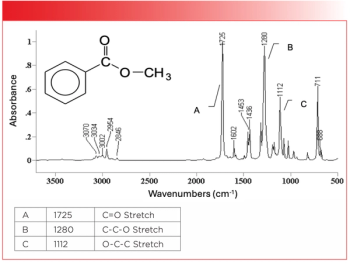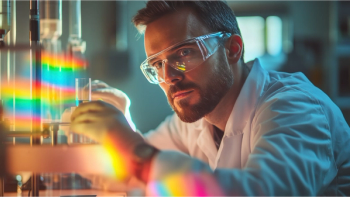
- June 2025
- Volume 40
- Issue 5
- Pages: 58
Investigating Changes in Extracellular Vesicles of Breast Cancer Patients with Raman Spectroscopy
Researchers proposed Raman spectroscopy (RS) as a tool to obtain the biochemical profile of circulating extracellular vesicles in the context of breast cancer.
A study published in Biosensors and Bioelectronics (1) proposed Raman spectroscopy (RS) as a tool to obtain the biochemical profile of circulating extracellular vesicles (EVs) in the context of breast cancer (BC). The technique was used to differentiate various extracellular particles (EPs) in blood, including lipoproteins (LPs) as well as EVs. In addition, the study evaluated the capability of RS to quantify major classes of biomolecules and compared these results with those obtained by traditional biochemical assays. Finally, compositional differences in large EVs (lEVs) and small EVs (sEVs) were assessed between BC patients and healthy controls. RS uncovered the presence of distinct biochemical signatures associated with BC, drawing attention to increased levels of nucleic acids and lipids in the BC group.
The most common cancer diagnosed in women and the second leading cause of cancer-related deaths among women worldwide (2), the early detection and monitoring of BC patients are critical factors for drastically improving their survival rates (3,4). However, the researchers conducting the study report that finding a method to achieve these objectives without subjecting patients to invasive instrumental investigations, which cause discomfort for them and incur high costs for the healthcare systems, remains difficult (1).
EVs have attracted considerable attention among the many possible components to be analyzed in a liquid biopsy due to their potential in cancer diagnosis, prognosis, and therapy response monitoring because of their early release from cancer cells (5,6). Acting as messengers in intercellular communication, EVs transport proteins, lipids, and nucleic acids which can influence a variety of biological processes (7).
The diagnostic potential of RS analysis of EVs was tested using a machine learning approach on data obtained from sEVs, as this class exhibited the most pronounced differences among groups. A support vector machine (SVM) algorithm with a linear kernel was developed by the researchers for their study, using the 17 selected features to discriminate between the two classes of subjects included. SVM was chosen because it represents a powerful supervised learning method capable of transforming high-dimensional data for binary classification. As the numerosity of the patients included in this study was too low for fully validating the results on an independent dataset, results were cross-validated by a leave-one-patient-out (LOOCV) method (1).
The authors of the study believe that their findings highlight the potential of RS as a rapid, label-free tool for analyzing the biochemical composition of circulating EVs and of the other EPs in the plasma of BC patients. The technique, in their opinion, effectively identifies distinct biochemical differences between EPs, and provides important information regarding how RS reflects their biochemical composition. Specifically,significant alterations in lipid and nucleic acid content were seen in sEVs from BC patients compared to HC, which suggests that EVs carry a unique biomolecular signature associated with BC—an observation that may have diagnostic potential (1).
However, the authors reported some limitations of their study, the most significant being the small number of patients included, stating that the low patient number limits the translation of these findings to clinics. They believe that larger cohort studies are needed to validate the approach and establish its utility in BC management. Additionally, future research should address the dependence on preprocessing techniques to mitigate variability in spectral intensity. Furthermore, RS still needs to demonstrate reproducibility across multiple centers and instruments to ensure generalizability to be truly implementable in clinical practice. Finally, the observed hints of EV-lipoprotein interactions in BC pathophysiology warrant further investigation. Understanding these interactions may provide a stronger biological significance to the spectral data, thereby enhancing the interpretation of RS findings in the context of BC diagnostics (1).
References
1. Bonizzi, A.; Signati, L.; Grimaldi, M. et al. Exploring Breast Cancer-Related Biochemical Changes in Circulating Extracellular Vesicles Using Raman Spectroscopy. Biosens. Bioelectron. 2025, 278, 117287. DOI:
2. Menon, G.: Alkabban, F. M.; Ferguson, T. Breast Cancer; StatPearls Publishing, 2024.
3. Cueva Bañuelos, J. F.; Rodríguez López, C.; Cortegoso, A. et al. Clinical Relevance and Therapeutic Application of CTCs in Advanced Breast Cancer. Adv. Exp. Med. Biol.2020, 1220, 147-164. DOI:
4. Zielonke, N.; Gini, A.; Jansen, E. E. L. et al. Evidence for Reducing Cancer-Specific Mortality Due to Screening for Breast Cancer in Europe: A Systematic Review. Eur. J. Cancer2020, 127, 191-206. DOI:
5. Dorado, E.; Doria, M. L.; Nagelkerke, A. et al. Extracellular Vesicles as a Promising Source of Lipid Biomarkers for Breast Cancer Detection in Blood Plasma. J. Extracell. Vesicles2024, 13, e12419. DOI:
6. Li, D.; Lai, W.; Fan, D. et al. Protein Biomarkers in Breast Cancer-Derived Extracellular Vesicles for Use in Liquid Biopsies. Am. J. Physiol. Cell Physiol.2021, 321, C779-C797.
7. Welsh, J. A.; Goberdhan, D. C. I.; O'Driscoll, L, et al. Minimal Information for Studies of Extracellular Vesicles (MISEV2023): From Basic to Advanced Approaches. J. Extracell. Vesicles 2024, 13 (2), e12404. DOI:
Articles in this issue
Newsletter
Get essential updates on the latest spectroscopy technologies, regulatory standards, and best practices—subscribe today to Spectroscopy.





